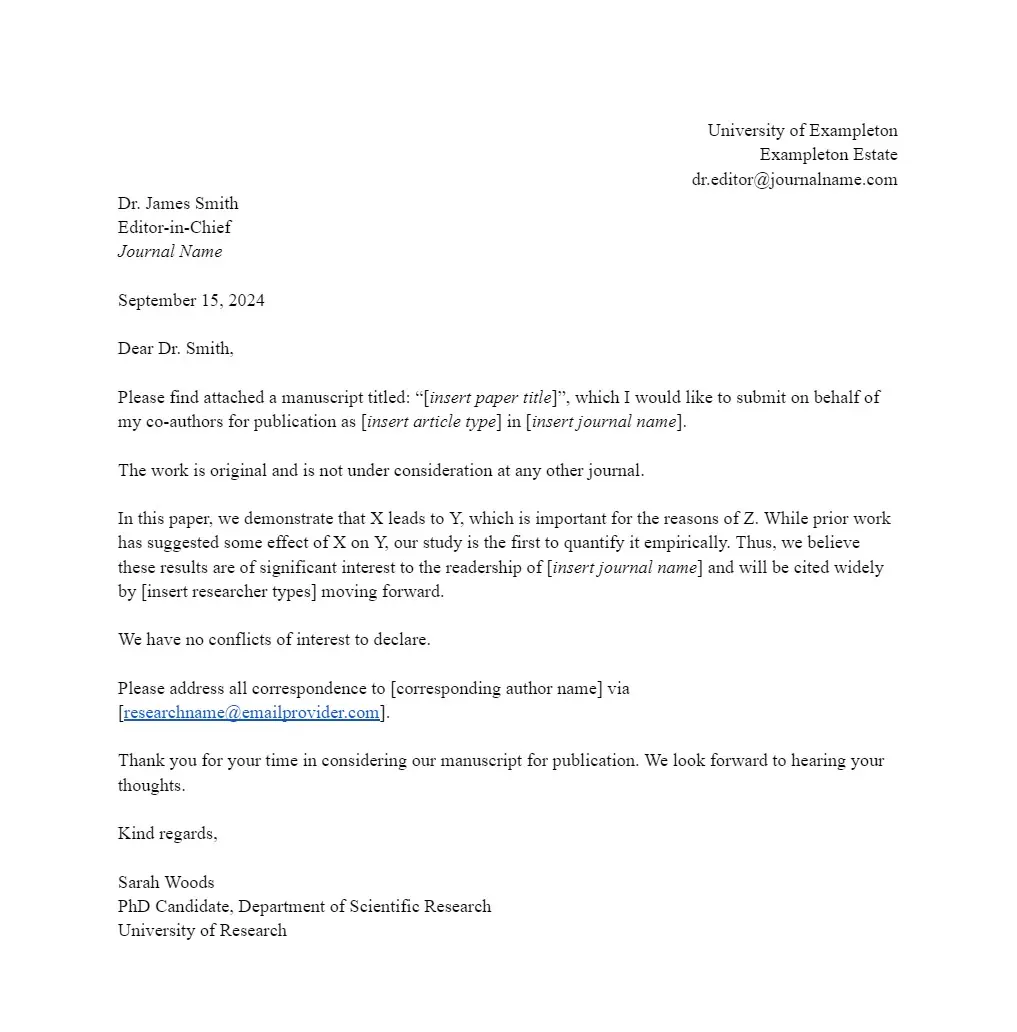Blog • Posted on Sep 16, 2024
How to Write a Cover Letter for Journal Submission
The cover letter is often the first thing a journal editor reads when considering a manuscript for publication. Therefore, it’s essential to concisely and clearly tell the editor everything they need to know to make a decision.
An effective cover letter can do wonders for helping the editor view your paper in a positive light. In this article, we cover all of the key elements to writing an effective submission cover letter.
Submission cover letter steps:
- 1. Address the editor by name (if known)
- 2. Include the paper’s title and journal name
- 3. Outline your research and why it’s appropriate
- 4. State that the research is not under consideration elsewhere
- 5. Declare any conflicts of interest
- 6. Denote the corresponding author
- 7. Thank the editor for their time
- Conclusion

1. Address the editor by name (if known)
Whenever possible, you should always address the editor by name. Much like a personalized email, addressing the editor by name helps establish a human connection and shows that you’ve researched the journal before submitting.
Journals unfortunately get a lot of spam submissions from authors using a ‘shotgun approach’, where they simply submit their manuscript to as many journals as possible until they are accepted. Consequently, journal editors can be a little wary when first considering a submission.
Addressing them by name assures them that your submission is not spam and that you have carefully considered appropriate journals for your work before ultimately deciding to go with them.
If you’re unsure who the editor is, most journal websites have pages dedicated to showing their editorial team.
2. Include the paper’s title and journal name
Next you’ll want to state that you’d like to submit your manuscript for publication in their journal. Here, you should include the title of your manuscript and the target journal name.
Again, this reassures the editor that your submission is not spam.
For tips on writing an effective paper title, read our guide on formatting a research paper for journal submission.
3. Briefly outline your research and why it’s appropriate
Step 3 is the meat in the sandwich, so to speak.
In a new paragraph, briefly outline your research and why it’s appropriate for the journal you’re submitting to. To do this well, you really need to put yourself into the editor’s shoes.
Journal editors are responsible for not only managing the types of content that are published in the journal, but they’re also responsible for ensuring the content that is published will (at minimum) be cited as many times as their current impact factor - or even better - many more times.
So with this in mind, do your best to outline why your work is not only appropriate for the journal’s readership, but also why you expect it to be cited frequently moving forward.
DO NOT repeat your abstract word-for-word. Remember, the editor already has access to your abstract. Instead, use this opportunity to create a 1-2 sentence take home message of your work.
This is much closer to a media summary than an abstract.
4. State that your paper is not under consideration elsewhere
If you weren’t already aware, your manuscript should only ever be under consideration at one journal at a time. This avoids wasting the time of the journal team and reviewers (who are working voluntarily) if your manuscript is accepted elsewhere.
On a fresh line, state that your paper is not under consideration at another journal and that all authors have authorized submission of this version.
5. Declare any conflicts of interest
If you have no conflicts of interest to declare - great! Simply state on a fresh line that you have no conflicts of interest to declare. If you do, be sure to describe these clearly.
For example, a medical researcher might receive consulting fees from a pharmaceutical company or own shares. When investigating the efficacy of a drug manufactured by that company, the researcher could exhibit bias toward research outcomes that are beneficial for the company because of their vested financial interest.
That isn’t to say that all conflicts of interest are malicious. Rather, it is simply to inform the reader that the connection exists so that they may take it into consideration when comparing your findings with other studies.
6. Denote the corresponding author and their contact details
Papers can sometimes have dozens of contributing authors. So it’s important to let the journal team know who all correspondence regarding the paper should be addressed to.
This is what we call the ‘corresponding author’. Make sure to also include an email address.
Note: the corresponding author is not always the primary author of a paper.
7. Thank the editor for their time
Editors generally receive very little compensation for their work. So it’s important to thank them for their time in considering your manuscript for publication in their journal.
This shows empathy and understanding, reinforcing a human connection that helps ensure your manuscript is viewed in a positive light.
FAQs
What should be included in a cover letter for journal submission?
A cover letter for journal submission should include the editor's name, the title of your paper, the name of the journal, a brief outline of your research, a statement confirming that the paper is not under consideration elsewhere, any conflicts of interest, and the corresponding author's contact details.
Why is it important to address the editor by name in a cover letter?
Addressing the editor by name helps establish a personalized connection and shows that you’ve carefully chosen the journal. It can also prevent your submission from being perceived as spam, which is common with non-personalized submissions.
What is the role of a corresponding author in a journal submission?
The corresponding author is responsible for all communication with the journal regarding the manuscript. They ensure that queries, revisions, and publication details are handled efficiently. This person may or may not be the primary author of the paper.
Conclusion
Submission cover letters are often an afterthought when preparing your research paper for submission. However, by following these steps covered in this article you should be well on your way to writing an effective cover letter.
Don’t forget to download our free submission cover letter template for the best results.
Now that you’ve written an effective cover letter, check out our range of paper editing services to give your paper the best possible chance of being accepted. Professionally edited manuscripts perform significantly better than unedited manuscripts not only at the submission stage but also in terms of long-term citations.
Found this article helpful? Join the RURU community to get notified whenever we post free resources.
Dr. Matt Biddick is a Senior Editor & Research Consultant at RURU. You can book sessions with him here.
